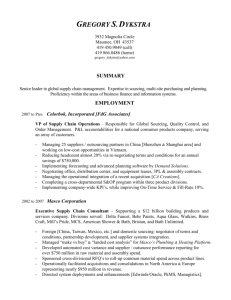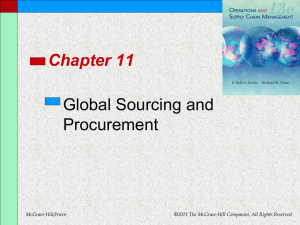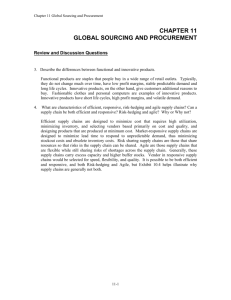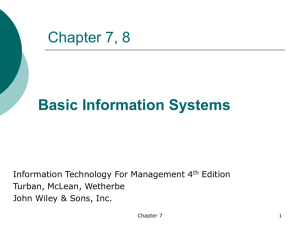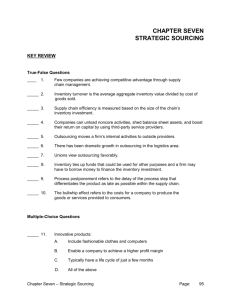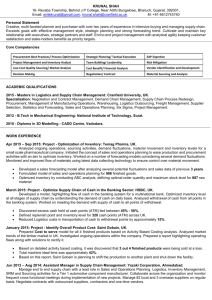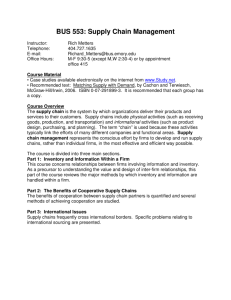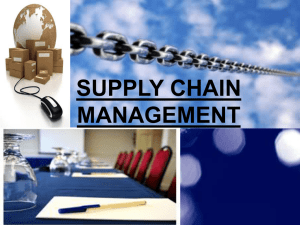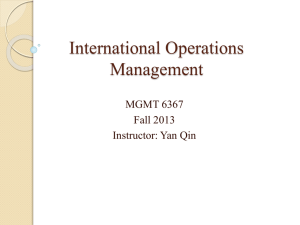PowerPoint
advertisement
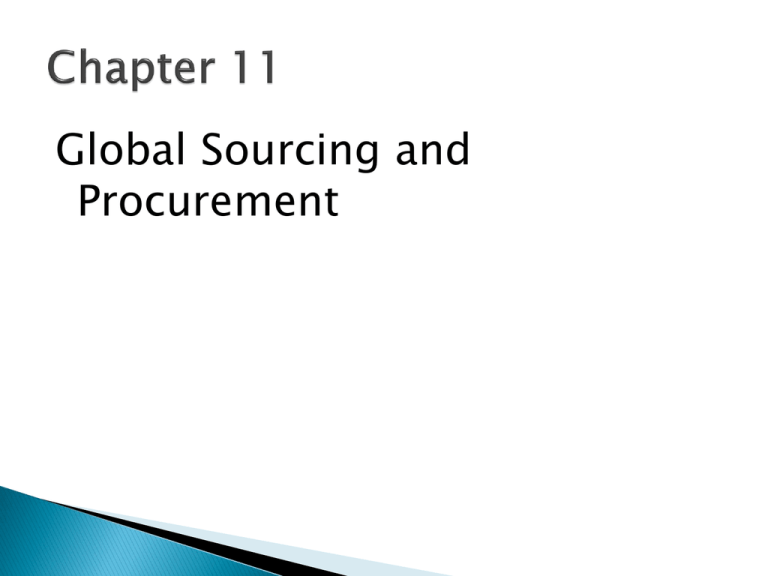
Global Sourcing and Procurement 1. 2. 3. 4. 5. 6. 7. Understand how important sourcing decisions go beyond simple material purchasing decisions. Demonstrate the “bullwhip effect” and how it is important to synchronize the flow of material between supply chain partners. Describe how characteristics of supply and demand have an impact on structuring supply chains. Know the reason for outsourcing capabilities. Illustrate what “green” sourcing is. Analyze the total cost of ownership. Calculate inventory turnover and days of supply. Strategic sourcing: the development and management of supplier relationships to acquire goods and services in a way that aids in achieving the immediate needs of the business In the past, sourcing was another name for purchasing As a result of globalization, sourcing implies a more complex process suitable for products that are strategically important LO 1 Specificity: refers to how common the item is and, in a relative sense, how many substitutes might be available ◦ Commonly available products can be purchased using a relatively simple process A request for proposal (RFP) is used for purchasing items that are more complex or expensive and where there may be a number of potential vendors Vendor managed inventory: when a customer actually allows the supplier to manage an item or group of items for them LO 1 LO 3 Bullwhip effect: phenomenon of variability magnification as we move from the customer to the producer in the supply chain ◦ A slight change in consumer sales ripples backward as magnified oscillations upstream, like the result of a flick of a bullwhip handle Continuous replenishment: inventory is replaced frequently, as part of an ongoing process LO 2 Functional products include the staples that people buy in a wide range of retail outlets, such as grocery stores and gas stations ◦ ◦ ◦ ◦ ◦ LO 3 Product life cycle of more than two years Contribution margin of 5 to 20 percent Only 10 to 20 product variations An average forecast error of only 10 percent Lead time for make-to-order products of from six months to one year Innovation can enable a company to achieve higher profit margins Newness of the innovative products makes demand for them unpredictable Typically have a life cycle of just a few months ◦ Imitators quickly erode the competitive advantage that innovative products enjoy ◦ Companies are forced to introduce a steady stream of newer innovations The short life cycles and the great variety typical of these products further increase unpredictability LO 3 LO 3 LO 3 1. 2. 3. 4. LO 3 Efficient supply chains: utilize strategies aimed at creating the highest cost efficiency Risk-hedging supply chains: utilize strategies aimed at pooling and sharing resources in a supply chain to share risk Responsive supply chains: utilize strategies aimed at being responsive and flexible Agile supply chains: utilize strategies aimed at being responsive and flexible to customer needs Outsourcing: the act of moving a firm’s internal activities and decision responsibility to outside providers Allows a company to create a competitive advantage while reducing cost An entire function may be outsourced, or some elements of an activity may be outsourced, with the rest kept in-house LO 4 LO 4 Logistics: the management functions that support the complete cycle of material flow ◦ Purchase and internal control of materials ◦ Planning and control of WIP ◦ Purchasing, shipping, and distribution of finished product Emphasis on lean inventory means there is less room for delivery errors LO 4 Being environmentally responsible has become a business imperative Many firms are looking to their supply chains to deliver “green” results Financial results can often be improved Through going green A comprehensive green sourcing effort should assess how a company uses items that are purchased internally It is also important to reduce waste LO 5 LO 5 Total cost of ownership (TCO): an estimate of the cost of an item that includes all the costs related to the procurement and use of an item, including any related costs in disposing of the item Can be applied to internal costs or more broadly to costs throughout the supply chain LO 6 LO 6 Inventory turnover: how often inventory is replaced during the year ◦ Cost of goods sold: the annual cost for a company to produce the goods or services provided to customers ◦ Average aggregate inventory value: the total value of all items held in inventory Weeks of supply: how many weeks’ worth of inventory is in the system at a particular point in time LO 7 Inventoryturnover Cost of goods sold Averageaggregateinventoryvalue Averageaggregateinventoryvalue Weeksof supply 52 Cost of goods sold LO 7 Cost of goods sold Averageaggregateinventoryvalue 40,190 87.56 turnsper year 228 231 Inventoryturnover Averageaggregateinventoryvalue 52 Cost of goods sold 228 231 52 0.59 week 40,190 Weeksof supply LO 7
